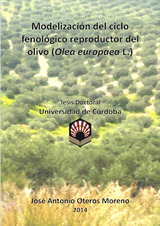Modelización del ciclo fenológico reproductor del olivo (Olea europaea L.)
Autor
Oteros, José
Director/es
Galán, CarmenGarcía-Mozo, H.
Editor
Universidad de Córdoba, Servicio de PublicacionesFecha
2014Materia
OlivoOlea Europaea L.
Reproducción
Ciclo fenológico reproductor
Córdoba (España)
Aceitunas
Producción
Área Mediterránea
Factores ambientales
Índices bioclimáticos
Índices autorregresivos
Índices biometeorológicos
Fenología floral
METS:
Mostrar el registro METSPREMIS:
Mostrar el registro PREMISMetadatos
Mostrar el registro completo del ítemResumen
El olivo (Olea europaea L.) es la principal especie arbórea con interés
agronómico en el área Mediterránea. Esta especie posee un ciclo reproductor que
muestra variaciones que responden tanto a su propia genética como al clima. La
presente tesis tiene como objetivo el análisis detallado y modelización del ciclo
reproductor del olivo y su respuesta a diferentes variables ambientales en el Sur de la
Península Ibérica. Para ello este trabajo se basa en el estudio de una base de datos
fenológicos, aerobiológicos y meteorológicos que abarcan 30 años en la provincia de
Córdoba (Andalucía, España), que es la segunda provincia productora de aceite de
oliva de Andalucía, principal región productora en el mundo. Un conocimiento más
profundo sobre los principales factores que controlan las variaciones anuales de la
floración y producción de fruto de esta especie es de gran interés no sólo a nivel
agronómico, sino también médico, dado el carácter alergógeno de sus granos de
polen, y ecológico, ya que el acebuche, Olea europaea var. sylvestris Brot., es un
arbusto característico y bioindicador del ecosistema mediterráneo. Aunque gran parte
de la tesis se centra en el comportamiento y respuesta fenológica del olivo en la
provincia de Córdoba, el capítulo IV de esta tesis aborda un estudio global sobre la
producción de aceituna en el área Mediterránea, analizando datos de Andalucía
(España), Italia y Túnez.
Se han analizado estadísticamente las relaciones que mantienen diferentes
factores ambientales con los aspectos más críticos del ciclo reproductor del olivo (la
intensidad de la floración, la fenología floral y la producción de fruto). A partir de éste
análisis se han desarrollado modelos descriptivos y predictivos del ciclo reproductor,
estudiando desde sus primeras fases hasta la producción final de cosecha, con un gran
interés científico y una alta aplicabilidad y transferencia a la sociedad, ya que permite
la predicción de importantes eventos biológicos, como fechas, duración e intensidad
de la floración, así como la producción de fruto con varios meses de antelación.
En los capítulos I y II, “Biometeorological and autoregressive indices for
predicting olive pollen intensity” y “Year clustering analysis for modelling olive
flowering phenology”, se analizan las características de la intensidad de la floración,... The olive (Olea europaea L.) is the leading commercial tree crop in the
Mediterranean area. Its reproductive cycle displays considerable variations due to
inherent genetic factors but also to climate response. This thesis provides a detailed
analysis and modelling of the olive reproductive cycle and its response to a range of
environmental variables in the southern Iberian Peninsula. Analysis was based on
phenological, aerobiological and meteorological data recorded over the last 30 years in
the province of Córdoba (Andalusia, Spain), the second-largest olive-oil-producing
province in Andalusia, which is in turn the world’s largest producing region. A more
thorough knowledge of the factors governing year-on-year changes in olive flowering
and fruit production is clearly of agricultural interest. It is also useful for medical
purposes—since olive pollen is highly allergenic—and for ecological reasons, given that
the wild olive Olea europaea var. sylvestris Brot., is a characteristic shrub used as a
bioindicator for Mediterranean ecosystem. Although the thesis focuses mainly on the
behaviour and phenological response of the olive tree in the province of Córdoba,
Chapter IV offers an overview of olive production in the Mediterranean area, drawing
on data for Andalusia (Spain), Italy and Tunisia.
A statistical analysis is made of the correlations between various environmental
factors and critical features of the olive reproductive cycle (flowering intensity, floral
phenology and fruit production). The results are used in the construction of models to
describe and predict the reproductive cycle, from the earliest phases through to
harvest. These models are of considerable scientific interest and can readily be
transferred for social applications, since they enable the prediction—several months in
advance—of major biological events such as the timing, duration and intensity of
flowering and the volume of fruit production.
Chapters I and II “Biometeorological and autoregressive indices for predicting
olive pollen intensity” and “Year clustering analysis for modelling olive flowering
phenology” analyse variables relating to flowering intensity, expressed in this
anemophilous species by the Pollen Index. The first chapter focuses specifically on the
construction of indices to account for year-on-year variations in olive flowering
intensity, while in the second chapter a cluster analysis is used to group years with...

